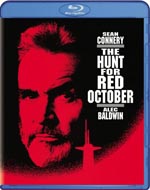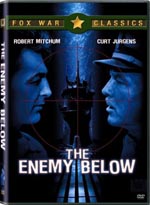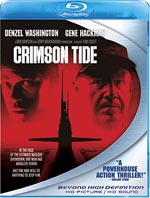
|
Das Boot: The Director's CutDirector: Wolfgang Petersen
Language:
SummaryThe StoryDas Boot is the story of a single mission of one U-boat and its crew. The film follows the U-96 from its departure from La Rochelle, France, through its patrols in the North Atlantic and its attempted penetration of the Mediterranean, until its fateful return to harbor once more in La Rochelle. We are witness to both the excitement of battle and the tedium of the fruitless hunt. The spectacular special effects and edge-of-your-seat action scenes make this not only the best U-boat movie ever made, but one of the best movies in the history of film.The MakingDas Boot, based on Lothar-Günther Buchheim's novel of the same name, was first filmed as a 145-minute movie, released in Germany in 1981 and in the United States in 1982, where it was nominated for six Academy Awards. It was also produced as a six-hour television mini-series aired in Germany in 1981. Das Boot: The Director's Cut, released in 1997, combines the action-packed sequences of the original movie with some character-development scenes contained in the mini-series. The result is a film that portrays the ordinary individuals that made up U-boat crews, and show the frequent tedium of their missions as well as the tension and excitement of attack and evasion.Petersen oversaw the editing of six hours of film, from which was distilled his vision of the perfect cut, including completely recreated and digitally mastered sound effects. The result - Das Boot: The Director's Cut. The original 1981 version had been the most expensive movie to date in the history of German film. The director's meticulous attention to detail resulted in the most realistic submarine movie, and one of the most historically accurate war movies, ever made. The U-boat set was mounted on a rig that could incline up to 45 degrees, and was vigorously shaken to simulate depth charge attacks. Gouts of cold water were hosed over the actors to similate the breaking ocean waves. Throughout the filming, the actors were forbidden to go out into the sunlight, in order to simulate the pallor of the U-boat men who seldom saw the sun throughout the duration of their missions. The actors also went through weeks of intensive training in order to learn how to move quickly and expertly through the narrow confines of the vessel. Director Wolfgang Petersen was admittedly obsessive about the structural detail of the U-boat set, remarking that "every screw" in the set was an authentic facsimile of the kind used in a World War II U-boat. Find out more about the making of Das Boot, including frequently asked questions, in the Notes section below. The MessageFew can dispute Das Boot's anti-war message. Petersen wanted to guide the audience through a "journey into madness," so that they would be able to see "what war is all about." Das Boot depicts the lives and the circumstances of the men serving aboard U-boats, and shows that, like all soldiers in all wars, they were ordinary individuals, each with their own hopes and fears, all with the desire to do their best for their comrades and their country.A lengthy critique of Das Boot and how it was received upon its initial release in Germany can be found in Michael L. Hadley's Count Not The Dead: The Popular Image of the German Submarine. Montreal: McGill-Queen's University Press, 1985. For more information about Das Boot: The Director's Cut, see its web page at www.dasboot.com.
NotesDas Boot FAQWhat are the names of the popular songs featured in the movie?* The song sung by the female performer in the bar at the beginning of the film was "Mon Gars" performed by Rita Cadillac. This song is on the Das Boot soundtrack. * The song the men are singing in the bar at the start of the film is "O du schöner Westerwald". Read the lyrics and hear the melody here. * "It's a Long Way to Tipperary" was performed by the Russian Army Chorus. You can purchase this song from Amazon on a 17-track Audio CD. * The French record which seemed to be the captain's favorite song ("you know the one") was "J'attendrai" sung by Rina Ketty. You can purchase this song from Amazon on a 22-track or 38-track Audio CD. * The song the band is playing when the boat is leaving harbor at the beginning of the movie is "Muss I Denn"; this one is on the Das Boot soundtrack. * The song the band is playing when the boat returns to harbor at the end of the movie is the Erzherzog-Albrecht-Marsch. You can purchase this song from amazon.de on a CD entitled Preußische und österreichische Märsche. You can also find it here at uboat.net as an MP3 file. Was a real U-boat used in the filming of Das Boot? In a manner of speaking, yes; but actually, no. Two full-size mock-ups of a Type VIIC boat were built, one for use in outdoor scenes, and one for the interior scenes. The mock-ups were built according to U-boat plans found in Chicago's Museum of Science and Industry. The appearance of interior and exterior was duplicated as closely as possible; however, the controls were non-functioning. The outdoor mock-up was propelled with a small engine. Additionally, a mock-up of a conning tower was placed in a water tank in the studio to simulate outdoor scenes not requiring a full view of the boat's exterior. The interior mock-up was mounted 16 feet off the floor and was shaken, rocked, and tilted up to 45 degrees by means of a hydraulic apparatus. Several models of varying scales were used for exterior shots; in some cases the camera speed was altered so that the wave action and model movement matched that of a full-size U-boat in the open Atlantic. A scene near the beginning of the movie shows a long row of occupied submarine pens; to achieve this shot using the single full-scale outdoor U-boat mock-up, the model had to be set up and filmed in one pen at a time, in varying stages of loading and repair. How long did it take to film? Production of Das Boot took three years (1979-1981). Most of the filming was done over a period of one year; in order to make the appearance of the actors as realistic as possible, the scenes were filmed in sequence over the course of the year. This allowed the camera to record the growth of beards and hair, the increasing pallor of skin, and the general signs of strain which marked the faces of the actors, who had, just like real U-boat men, spent many months in a cramped, unhealthy atmosphere. Where was the film shot? The shots of U-96 leaving and returning to base were filmed at the U-Bunker of La Pallice and in the Atlantic Ocean, using the outdoor mock-up. Some shooting of the reduced-scale models was done off Heligoland in the North Sea. Indoor shots and shots using the conning tower mock-up were filmed in Munich at Bavaria Studios. Action occurring in the Straits of Gibraltar was shot on Lake Constance, and the night approach to Vigo was filmed using specially-constructed basins and scale replicas of merchant ships obtained from a model club. Although Lorient was the U-boat base used in the novel, La Rochelle/La Pallice was chosen for filming because its appearance had changed much less in the intervening decades than that of Lorient. The submarine pens were still in good condition, and many artifacts, including torpedo containers, were found and used as props in the filming. Shooting at La Pallice was restricted to weekends, so the harbor could more easily be cleared of anachronisms in the form of modern vessels. How was the air raid scene at the end of the movie done? The air raid scene required 200 French extras and DM1 million in explosives. No British planes of the correct period could be found to carry out the bombing; instead, vintage American planes owned by a French Aero club were painted with appropriate insignia and flown by French pilots. The sinking of U-96 in the final scene was facilitated by the fact that the outdoor mock-up had itself recently broken up and sunk; it was raised and repaired, and large hinges were added so that, when underwater cables were pulled, the mock-up would fold up and sink on cue in a convincing manner. What was special about the camera work? Most of the shots were filmed using a hand-held Arriflex, with a gyroscope to provide stability. This was cinematographer Jost Vacano's design, a reinvention of the Steadicam on a smaller scale, to enable the camera to be carried throughout the interior of the mock-up. Vacano outfitted himself with full-body padding, to minimize injury as he ran the length of the boat and as the mock-up was rocked and shaken. The handheld-camera technique was effective in conveying the claustrophobic atmosphere of the boat; in addition, by showing the audience only what the crew would see, and relying on sounds to convey action outside the boat, Petersen was able to heighten audience suspense. Because of the noise made by this camera, sound could not be recorded during filming, but had to be added later in the studio. How much did it cost to make? DM25 million ($40 million in 1997 dollars); no German film has exceeded that budget to this day. What is included in the video and DVD versions? Some video versions of Das Boot: The Director's Cut include a short segment on the movie's making at the end of the feature. The DVD version includes both German and English DD 5.1 soundtrack (some editions also include Spanish DD 2.0), commentary by director Wolfgang Petersen, director's cut producer Ortwin Freyermuth and actor Jürgen Prochnow. Yellow subtitles are presented in English, Spanish, and/or French, depending on the edition. Some versions also include an informational booklet. **Little-Known Fact** Production for this movie originally began in 1976. Several American directors were considered, and the Kaleu was to be played by Robert Redford. Fortunately, disagreements sprang up among various parties and the project was shelved. The source of much of the information in this section was: Krug, Hans-Joachim. June 1996. "Filming Das Boot." USNIP, 62-67. Krug was first officer on U-219. Due to his experience both in U-boats and later as a cameraman, he served as a knowledgeable consultant during the making of Das Boot. |
Purchase information:  Get Das Boot: The Director's Cut now at amazon.co.uk
Get Das Boot: The Director's Cut now at amazon.co.uk  Get Das Boot: The Director's Cut now at amazon.de
Get Das Boot: The Director's Cut now at amazon.de






